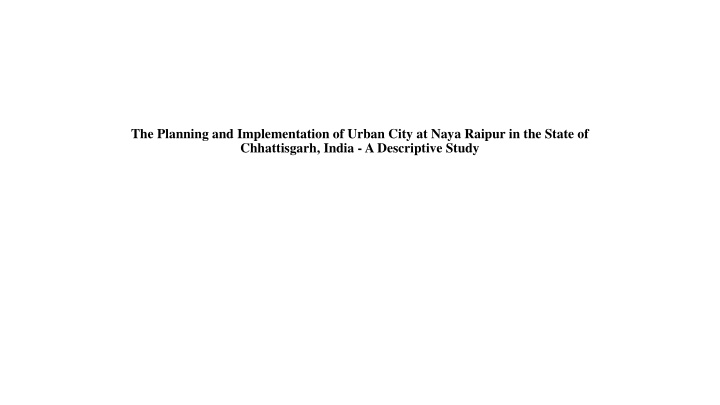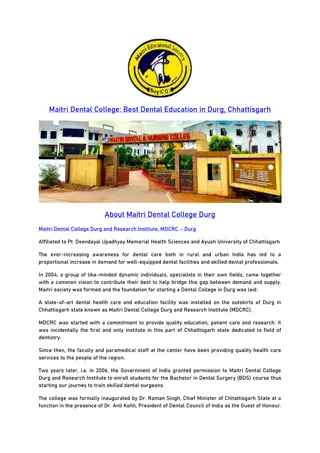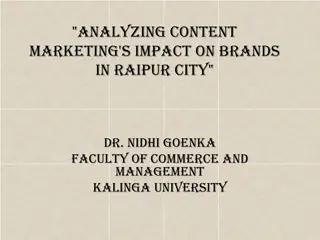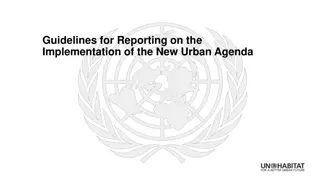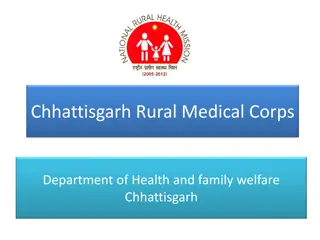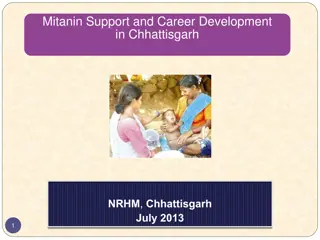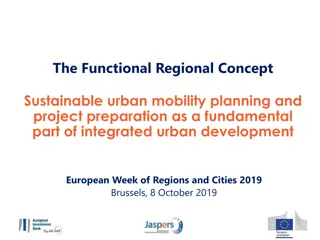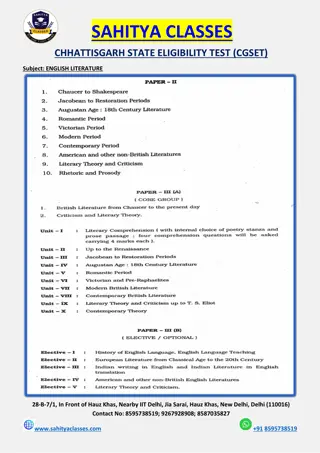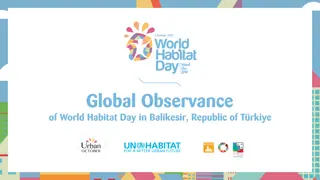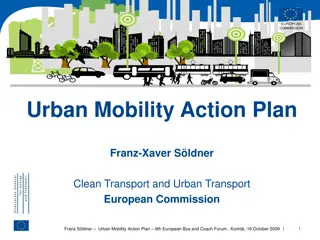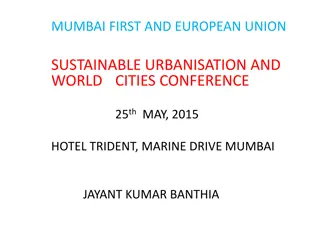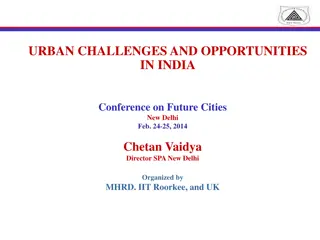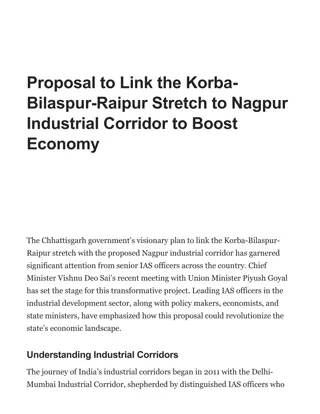Planning and Implementation of Urban City at Naya Raipur, Chhattisgarh
Global development is deeply linked to urbanization, emphasizing the importance of sustainable cities and the concept of Smart Cities. This descriptive study focuses on Naya Raipur in Chhattisgarh, India, discussing its conception, construction, and objectives for economic growth, social inclusion, and environmental sustainability. Explore the evolution and background of Naya Raipur as a model city promoting advanced technology and urban planning strategies.
Download Presentation

Please find below an Image/Link to download the presentation.
The content on the website is provided AS IS for your information and personal use only. It may not be sold, licensed, or shared on other websites without obtaining consent from the author.If you encounter any issues during the download, it is possible that the publisher has removed the file from their server.
You are allowed to download the files provided on this website for personal or commercial use, subject to the condition that they are used lawfully. All files are the property of their respective owners.
The content on the website is provided AS IS for your information and personal use only. It may not be sold, licensed, or shared on other websites without obtaining consent from the author.
E N D
Presentation Transcript
The Planning and Implementation of Urban City at Naya Raipur in the State of Chhattisgarh, India -A Descriptive Study
Mariyam Ahmed Assistant Professor mariyam.ahmed@kalingauniversity.ac.in Kalinga University, Kotni, Near Mantralaya, Naya Raipur, C.G 492101 Satvik Jain Assistant Professor satvik.jain@kalingauniversity.ac.in Kalinga University, Kotni, Near Mantralaya, Naya Raipur, C.G 492101
ABSTRACT: Global development is largely dependent on urbanisation, and sustainable and attractive cities are made possible by good urban planning. With the population's significant shift towards urbanisation comes a demand for the Smart City. The idea of a "Smart City" has recently gained popularity in both urban and rural areas of the world. An improved lifestyle built on the foundation of cutting-edge technology and communication systems is the aim of a smart city. This research article offers a descriptive analysis of the conception and construction of Naya Raipur, a contemporary metropolis situated in the Indian state of Chhattisgarh. To build a model city that promotes economic growth, social inclusion, and environmental sustainability, the article discusses the primary objectives, planning tactics, and implementation processes used.
INTRODUCTION: Most modern towns and cities are the result of an evolutionary process in which some of the larger villages or a group of villages grew and diversified more quickly than others. While the size and variety of the population's occupational structure have typically been highlighted in census definitions of urban areas, settlements have also expanded geographically and frequently diversified in terms of their roles as markets, administrative capitals, industrial hubs, or tourist towns.
Background of Naya Raipur: The main city in the new state of Chhattisgarh, Raipur, was chosen as the capital when it was established on November 1st, 2000. For many years, central India's market city of Raipur has been thriving. Nevertheless, it was ill-prepared to assume its new role as the administrative capital of a quickly expanding state because of its already overburdened civic infrastructure. The need for a new city, its location, and the method of financing its development were all hot topics of discussion. The fact that Chhattisgarh's political leaders and its citizens were able to agree to create a sizable greenfield metropolis near Raipur is truly an amazing accomplishment. The new city, which has been given the name "Naya Raipur," would simultaneously function as the State's administrative centre and meet the infrastructure needs of local industry and trade. Before deciding on the city's exact location, numerous surveys and research were conducted.
PRECINCTS The city is designed for a population of 5.6 lakh. The city has two prominent gateways that mark entry to the Naya Raipur City one to the north and the other to the west. Naya Raipur has the following precincts: i. Government Complex to include Secretariat,Assembly, Government offices, and Police Headquarters area. ii. Cultural Heart to include Museum,Art Gallery, Library, Theatres, Convention centre and International Centre. iii. City Centre to include city level shopping malls, commercial offices, restaurants, multiplexes, and other areas of recreation. iv. University including research and institutional complexes. v. SoftwareTechnology, Exhibition and Business centers vi. Central City Park around an existing vast water body as one of the biggest city parks in the country. Park and Sports Centre in the North end to include urban forest, theme park and sports complex. City Park South to includeTheme Park, Jungle Safari, Golf Course and Film City. vii. Transport and integrated freight complex to service the city and its industrial area. viii. Living areas with medium density development for the creation of a peaceful environment envisaged for the city.
Literature review: Jajoo, S. (2014) Stated that Urban planning is the need of the hour in a rapidly developing county like India. In essence, urban planning enhances the quality of land at a reasonable cost. Naya (New) Raipur is the new planned capital of the Indian state of Chhattisgarh and is one of India s few planned cities. Over the next decade it will drastically change the landscape of the state of Chhattisgarh. This new planned development is quintessential in growing this backward region and providing for future infrastructure. Dash, S., & Joshi, M. (2021) stated that energy consumption in India is rising faster in residential buildings, primarily due to the usage of air conditioning systems in summer to provide comfortable conditions to the occupants. Passive cooling techniques offer the best solutions without using mechanical or electrical components to lower electricity bills. Shukla, H., Jha, R., Singh, V., & Baier, K. (2013) stated that in the present scenario of urbanization, the population of Raipur City is increasing rapidly, accordingly, the use of groundwater is also increasing and so as the susceptibility of groundwater contamination. This study reveals the findings of the intrinsic groundwater vulnerability assessment model, DRASTIC applied in the study area using the geographical information system (GIS) technique.
The objective of the research: To study the economic change and social transformation in the state. To study the efficient engine of growth and prosperity. To study the impact on the servicing hub not only in the manufacturing of goods but also in the Information Technology and Bio-Technology sectors. To study the financial centre, the hub of trade and hospitality sectors, the hub of cultural services, the hub of affordable and high-quality medical services, hub of quality educational facilities, in the region.
The hypothesis of the study: 1. This study shows that the impact of Naya Raipur project has positively impacted the economic, social, and environmental quality of life in the region. 2. This study shows that the smart city project has increased employment opportunities. 3. This study shows that the smart city project has improved public services. 4. This study shows that the smart city project has reduced the pollution and traffic population in the region.
MethodologyAdopted in Plan-Making As stated above while venturing to prepare the Development Plan for Naya Raipur, basic studies were made in the form of a secondary survey of data on Chandigarh (the first state capital of independent India) and Raipur, the elder sister, and the most important "organic" metropolis in the region. Primary studies related to existing village population, site conditions, those related to water source/ water table etc were also carried out. On the selected site, a thorough analysis was made of the given assets and constraints. From this emerged a four-focus city structure, cruciform in shape. The foci are major work-centres, namely the capital complex in the east, the freight complex/light industries in the north, the software hub in the west and the institutional/tourist hub in the south.
Data Collection andAnalysis: The information collected from various secondary sources like government reports, and academic studies, proves that the planning to build a new smart city has evolved in a positive way apart from the other negative aspects such as relocating the villagers and paying compensatory amounts to them. An open-ended survey done among the 12 villages nearby, it proves that most of the people were dissatisfied with NRDA due to rehabilitation. But they were also optimistic about the future as it aims at providing better career opportunities and improving prospects of future generations and benefit society. Based on the information collected from the online sources, it is revealed that there are not many employment opportunities present as per the plans made earlier due to a lack of skilled labour, wages provided and resources available nearby.
Conclusion: While developing a new city from scratch not only required a wholesome amount of money but also takes the emotions of people along with it. Most of the people seem dissatisfied due to dislocation, the amount of money received, and the lack of opportunities provided. But they were also optimistic for the future generations to come, who will not require to thrive in the unfavourable conditions of a city. My recommendations will be such that it is the requirement to educate the indigenous people regarding different schemes related to investment and provide them with skilled-based training. The city is crowded as people have started to shift from the old city, and the coming time will tell us more about the design, sustainability and implementation of the Naya Raipur Smart City.
REFERENCES Naya Raipur DevelopmentAuthority, http://www.nayaraipur.com/ Jajoo, S. (2014). Satisfaction Survey of a Displaced Population Affected by a New Planned Development of Naya Raipur, India. International Journal of Humanities and Social Sciences, 7(11), 2976-2980. Dash, S., & Joshi, M. (2021). Passive Cooling Strategies for Improving Thermal Performance of Residential Buildings in Naya Raipur, Chhattisgarh. Research & Reviews: Journal of Architectural Designing, 3(2). Shukla, H., Jha, R., Singh, V., & Baier, K. (2013). Groundwater vulnerability assessment using DRASTIC model a case study of Raipur and Naya Raipur, Chhattisgarh, India. Water, 10, 1-11.
